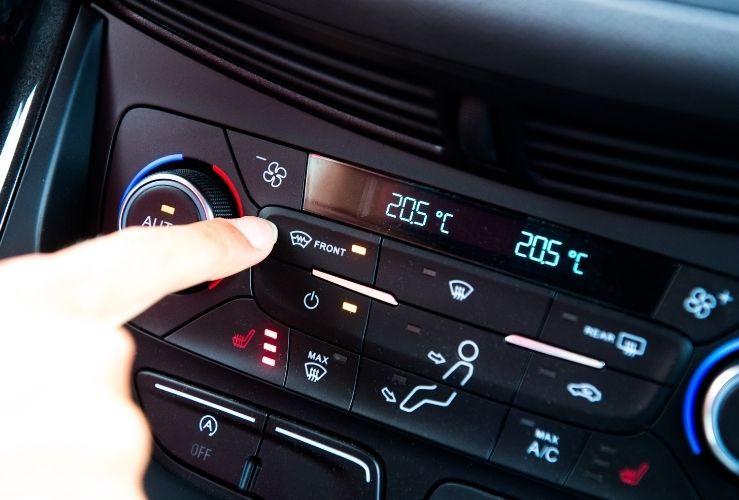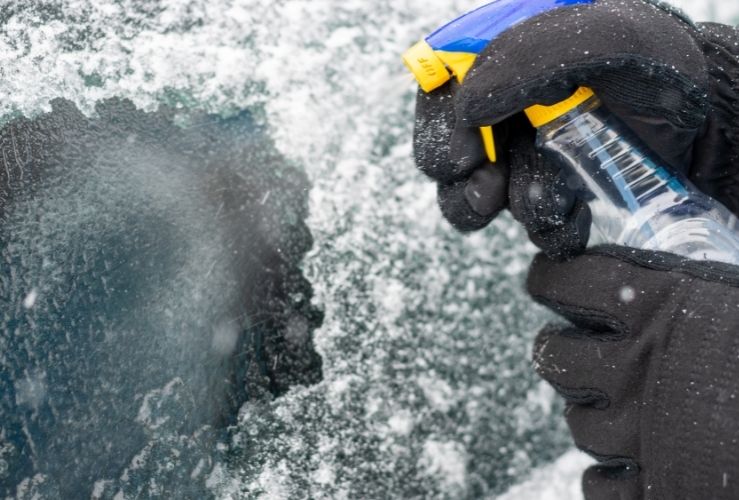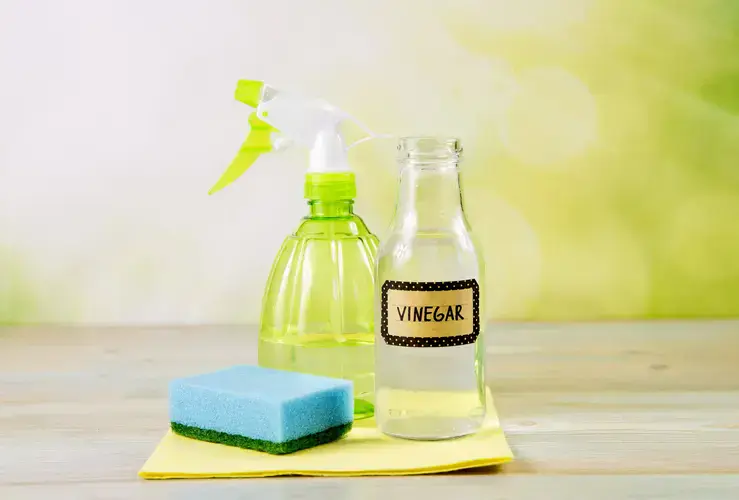As colder temperatures become the norm over winter, many of us will experience waking up to a frosted windscreen, rear window and mirrors.
Each winter, UK roads become significantly more dangerous. Between 2016 and 2020, there were 44,783 accidents attributed to wintry conditions—such as snow, ice, fog, flood, or darkness—averaging almost one accident per hour during those months.
But why does frost form in the first place? It’s a simple process: when the air temperature drops below freezing, any moisture in the air condenses on cold glass surfaces, turning into ice crystals.
If the car’s interior is damp, condensation can also freeze on the inside of your windscreen.
If you're in a hurry for work or school, it's frustrating to find your windscreen layered in ice. That's why it's important to be prepared so you can solve the problem quickly and safely - and then go about your business.
Here are some effective ways to clear your car of ice.

Use your car's heating systems
Your car may have built-in systems for deicing your car’s glass.
Be sure your windscreen wipers are off before you begin, as the rubber could get damaged if they scrape across the ice.
Firstly, turn on the engine and direct the warm air blower onto the windscreen. Next, turn on the windscreen heater and heated mirrors - if your vehicle has them.
Remove moisture from the air in the cabin by turning on the air-con system. This should reduce or eliminate mist - which can obstruct your view of the road.
Use a lint-free cloth to remove the melting ice. Avoid using your hands as the oil in your skin could smear the glass, further obscuring your view. If you must use your hands, remove any hard jewellery - especially diamond rings, as they can easily score your windscreen.
Don't be tempted to leave your car while the engine is running. Car thieves have been known to target motorists who do this. It's common enough to have been given a name - "frosting".
Your insurance policy almost certainly stipulates that you must not leave your vehicle unattended when the engine is running.
Don’t be tempted to leave your car while the engine is running. Car thieves have been known to target motorists who do this. It’s common enough to have been given a name – “frosting”.
Your insurance policy almost certainly stipulates that you must not leave your vehicle unattended when the engine is running.
As you wipe your car clean, pay attention to the wind mirrors, rear window and lights, as they must all be clear before you drive off.
Using your car’s engine heat and heating systems alone might not be the quickest hot-to-deice-a-car solution, but it’s speeded up with a bit of elbow grease (see below)
Brush (for snow removal)
If your car is covered in snow, you can use a brush to wipe it off before tackling any ice underneath.
Ice-scrapers
The go-to how-to-deice-your-car solution, scrapers are hard enough to remove ice but won’t scratch your glass.
Ice scrapers may be used in combination with de-icer (see below).
You can choose from classic paint-scraper style products (never use an actual paint scraper!) and cone-shaped scrapers.
Using a hand ice scraper alone is a “green” alternative to using a deicer solution (see below).
Be sure the windscreen is free of grit and mud etc since this can scratch your glass.
Heated/electric ice scrapers
You can also buy heated ice scrapers which make light work of ice.
Some products have rotating blades as well as a heating unit, while others are paint-scraper-style options with heated edges. These may also mean you don’t have to use a deicer solution.
Again, ensure the glass is clear of grit and mud to avoid abrasion.

Use a shop-bought deicer solution
As well as using your car's heating systems to clear the ice, you may also use a commercially-available deicer solution (car defroster).
If your car doesn't have the heating systems mentioned, running the engine for a few minutes should help clear the ice.
This, combined with using deicer and/or a lint-free cloth, should mean you're ready to drive away after a short wait. It should also help reduce mist build-up on the inside of the windows.
Some people have concerns about the environmental impact of deicers which often contain methanol. Deicers should be kept well out of the reach of children since methanol can be highly toxic if ingested. Ensure the solution does not come into contact with rubber window seals or any other part of your car.
Use a homemade de-icer: rubbing alcohol and water
If you don’t have a shop-bought car defroster solution available, you can make your own by mixing 2/3 rubbing alcohol with 1/3 water.
Because alcohol does not freeze until -128°C, it will never do so - barring an impending ice age.
Raiding the spirits cabinet might also work - but it will be a very costly solution.
Take care when using rubbing alcohol, since it is also toxic if ingested. Prolonged contact with the skin may also cause rashes and itching etc.
Take care if you try using water to defrost your windscreen
Whatever you do, do not pour boiling water on your windscreen. It’s arguably among the worst windscreen defroster solutions.
Hot water can actually freeze quicker than ambient-temperature water, and has the potential to damage your windscreen - especially if it already has chips or cracks. If water expands in these gaps, it could force the windscreen to develop larger fractures. In rare cases, it could instantly shatter the glass.
The quick-freezing nature of hot water is down to the fact that it evaporates quickly, meaning there is less of it to freeze - so it does so more quickly.
If you do try the water-pouring method, only use room-temperature or luke-warm water.
In reality, the jury is still out as to the effectiveness/safeness of using water to clear your windscreen - although many motorists find it a reliable car defroster technique.
Use a domestic fan heater
This solution might help if your car does not have built-in heating systems.
If you have access to a domestic fan heater and an extension cord, sit it in your car for 10-15 minutes, directing it at the windscreen. This should also help remove moisture from the air so your windows don’t steam up.
Credit card conundrum
Using a credit card to clear your windscreen runs the risk of scratching your glass. It might also damage the card.
It's best to avoid using other similarly-hard objects - such as CDs.
Ice on the inside of the windscreen: How do I effectively remove ice from the inside of the windscreen?
If condensation/moisture has built up inside your vehicle, in very low temperatures you may find ice on the inside of your windshield.
Methods of tackling the problem of ice on the inside of the windscreen include:
- Turning on engine and heating systems to melt the ice
- Scraping away ice with a scraper
- Placing a fan heater inside vehicle with the doors open
Prevent ice on the inside of windscreen:
The following can help to prevent the build up of ice and condensation on the inside of your windscreen:
- Remove any damp items/replace damaged door seals
- Buy a car dehumidifier bag
- Buy an electric car dehumidifier
- Keep inside of windscreen clean since moisture can adhere to dirt particles
Preventing ice build up in the first place
Invoking Shakespeare's "readiness is all" for an iced-up windscreen is perhaps overkill, but the sentiment does apply; a little effort in the evening could save you stress and time in the morning.
Cover your windscreen with a section of cardboard or old carpet. This should insulate the glass enough to prevent ice from forming.
Use the wipers to hold the cardboard in place, but avoid this approach if the cover is heavier (e.g. a piece of carpet) as this could damage the wipers.
Be sure to cover your wing mirrors too.
For advice on damaged windscreens, see our guide: Chipped windscreen: here’s what to do.
Park facing east
Since the sun rises in the east, parking your car in this direction will harness the sun's natural heat to help melt ice on your windscreen.
You may still need to clear windows that are in the sun's shadow - and this method won't work if it's still dark when you start your day!

Use vinegar and water
You can help prevent ice build up by mixing vinegar (2/3) and water (1/3) and spraying it on your windows in the evening (before the temperature drops).
Vinegar contains acetic acid which lowers the freezing point of water so it's harder for ice to form.
This cheap car defroster mix, combined with covering your windows should mean you're ready to drive off in the morning without delay.
Innovative Defrosting Technology
In addition to traditional methods, newer technologies are making winter mornings easier for motorists.
Many modern vehicles now feature heated windscreen coatings that can melt frost in minutes without scraping. Some car manufacturers offer smartphone apps to remotely pre-heat and defrost your car before you step outside.
Electric vehicles (EVs) in particular often include preconditioning systems that warm both the cabin and windscreen while the vehicle is still charging, saving battery range and time on the road.
These innovations provide safer, faster and more convenient alternatives to manual methods.
Driving with a clear view
It’s an offence to drive a vehicle if your view of the road is obscured by anything - including ice and condensation. You could be handed a £100 fine and three points on your licence if the police catch you.
More importantly, being unable to see clearly out of your windows puts you and other road users at risk.
“Regulation 30 of the Road Vehicles (Construction and Use) Regulations 1986 (SI 1986 No. 1078 as amended) requires that:
(3) All glass or other transparent material fitted to a motor vehicle shall be maintained in such condition that it does not obscure the vision of the driver while the vehicle is being driven on a road.” - gov.uk
The practice of driving with only a small area of glass free of ice is sometimes called "portholing" - and should be avoided at all cost.
Quick Tips for Rapid Defrosting
If you’re short on time, here are some fast, safe methods:
- Start the engine and set blowers to maximum heat with air-con on, while gently scraping ice.
- Spray a de-icer solution before scraping to loosen ice quickly.
- Use a heated scraper to cut through frost even faster.
- Keep a windscreen cover on overnight to avoid scraping altogether.
Regional Frost Tips Across the UK
- Scotland – Expect heavier overnight frosts; keeping a de-icer and scraper in your car is essential. Consider heated covers for frequent sub-zero mornings.
- Northern England – Early morning frost is common; parking under street lighting can help reduce ice build-up.
- Midlands – Conditions vary; prevention methods like vinegar spray and covers work well.
- Southern England – Frost is lighter but still disruptive; quick de-icer sprays are usually sufficient.
- Coastal areas – Higher humidity means frost can form even at slightly warmer temperatures; a dehumidifier bag inside the car can reduce interior icing.
Frequently Asked Questions
No, leaving your car unattended with the engine running is both unsafe and illegal in the UK. Opportunistic thieves often target idling cars, and most insurance policies will not cover theft in these circumstances. Always stay with your vehicle while defrosting.
The quickest safe methods include spraying a de-icer solution before scraping, using a heated scraper, or pre-heating your car with built-in systems or remote preconditioning. Avoid shortcuts like boiling water, which can crack the glass.




